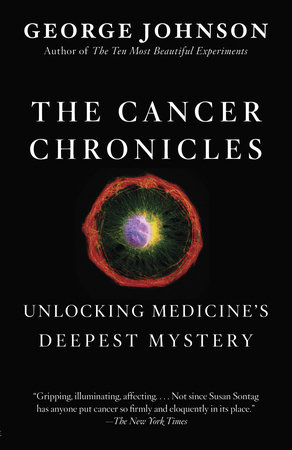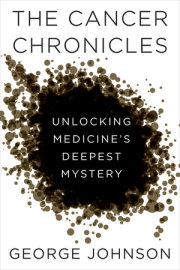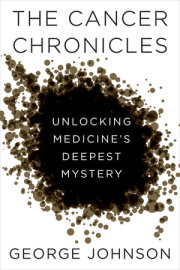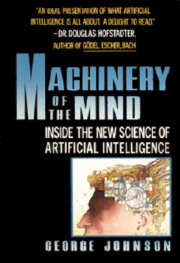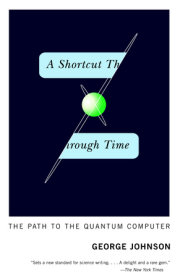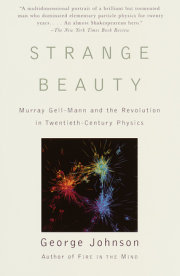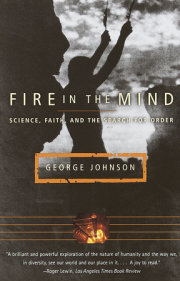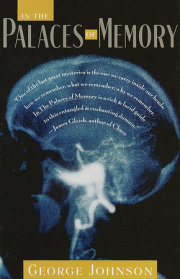Chapter 1
Jurassic Cancer
As I crossed a dry, lonesome stretch of the Dinosaur Diamond Prehistoric Highway, I tried to picture what western Colorado—a wilderness of sage-covered mesas and rocky canyons—looked like 150 million years ago, in Late Jurassic time. North America was breaking away from Europe and Asia—all three had formed a primordial supercontinent called Laurasia. The huge land mass, flatter than it is today, was drifting northward a few centimeters per year and was passing like a ship through the waters of what geographers would come to call the Tropic of Cancer. Mile-high Denver was near sea level and lay about as far south as where the Bahamas are today. Though the climate was fairly dry, webs of rivulets connecting shallow lakes and swamps covered part of the land, and vegetation abounded. There were no grasses or flowers—they had yet to evolve—just a weird mix of conifers commingling with ginkgos, tree ferns, cycads, and horsetails. Giant termite nests soared as much as thirty feet high. Splashing and stomping through this Seuss-like world were Stegosaurus, Allosaurus, Brachiosaurus, Barosaurus, Seismosaurus—their bones buried far below me as I made my way from Grand Junction to a town called Dinosaur.
Occasionally one can glimpse outcroppings of the Jurassic past, exposed by erosion, seismological uplift, or a highway department road cut—colorful bands of sediment that form a paleontological treasure house called the Morrison Formation. I knew what to look for from photographs: crumbling layers of reddish, grayish, purplish, sometimes greenish sediment—geological debris piled up over some 7 million years.
Just south of the town of Fruita on the Colorado River, I hiked to the top of Dinosaur Hill, stopping for a moment to pick up a pinch of purplish Morrison mudstone that had fallen near the trail. As I rolled it in my fingers it crumbled like dry cookie dough. On the far side of the hill, I came to a shaft where in 1901 a paleontologist named Elmer Riggs extracted 6 tons of bones that had belonged to an Apatosaurus (the proper name for what most of us call a Brontosaurus). Alive and fully hydrated, the 70-foot-long reptile would have weighed 30 tons. Riggs encased the bones in plaster of paris for protection, ferried them across the Colorado on a flat-bottom boat, and then shipped them by train to the Field Museum in Chicago, where they were reassembled and put on display.
After making my way north to Dinosaur (population 339), where Brontosaurus Boulevard intersects Stegosaurus Freeway, I stood at an overlook and watched Morrison stripes in a canyon reddening with the setting sun. But it was a little farther west, along the Green River in the western reaches of Dinosaur National Monument, that I saw the most beautiful example: a cliffside of greenish grays slumping into purples slumping into browns. It indeed resembled, as the woman at the park headquarters had told me, melted Neapolitan ice cream.
It was somewhere in these parts that a dinosaur bone was discovered that displays what may be the oldest known case of cancer. After the dinosaur died, whether from the tumor or something else, its organs were eaten by predators or rapidly decomposed. But the skeleton—at least a piece of it—gradually became buried by windblown dirt and sand. Later on, an expanding lake or a meandering stream flowed over the debris, and the stage was set for fossilization. Molecule by molecule minerals in the bones were slowly replaced by minerals dissolved from the water. Tiny cavities were filled and petrified. Several epochs later dinosaurs were long extinct, their world overlaid by lakes and deserts and oceans, but this fossilized bone, encased in sedimentary rock, was preserved and carried through time.
That hardly ever happened. Most bones disintegrated before they could become fossilized. And of the fraction that survived long enough to petrify, all but a few remain buried. The specimen, now labeled CM 72656 and housed at the Carnegie Museum of Natural History in Pittsburgh, was a survivor. Unearthed by a rushing river or exposed by tectonic forces—somehow it was delivered to the surface of our world where, 150 million years after the animal died, it was discovered by some forgotten rockhound. A cross-section was cut with a rock saw, polished, and after passing through who knows how many human hands, the fossil found its way to a Colorado rock shop where it caught the eye of a doctor who thought he knew a case of bone cancer when he saw one.
His name was Raymond G. Bunge, a professor of urology at the University of Iowa College of Medicine. In the early 1990s, he telephoned the school’s geology department to ask if someone would come evaluate a few prize specimens in his collection. The call made its way through the switchboard to Brian Witzke, who on a cold autumn day bicycled to the doctor’s house and was presented with an attractive chunk, 5 inches thick, of mineralized dinosaur bone. Viewed head-on, the fossil measured 6.5 by 9.5 inches. Lodged inside its core was an intrusion, now crystallized, that had grown so large it had encroached into the outer bone. Bunge suspected osteosarcoma—he had seen the damage the cancer can do to human skeletons, particularly those of children. Oval in shape and the size of a slightly squashed softball, the tumor had been converted over the millennia into agate.
The fragment was too small for Witzke to identify the bone type or the species of dinosaur, but he was able to provide a geological diagnosis: The reddish-brown color and the agatized center were clues that it came from the Morrison Formation. Bunge remembered buying the souvenir somewhere in western Colorado—burnished pieces of petrified dinosaur bone were a favorite among collectors—but he couldn’t remember the precise location. He gave the rock to the geologist, asking that he seek an expert opinion.
Other projects intervened, and so the fossil sat almost forgotten atop a filing cabinet in Witzke’s office, until the day he sent it to Bruce Rothschild, a rheumatologist at the Arthritis Center of Northeast Ohio who had expanded his practice to include dinosaur bone disease. He had never seen a clearer or more ancient example of prehistoric cancer. His next step was to determine just what kind of cancer it was.
The tumor, it turned out, didn’t exhibit the ill-defined margins or the layered, onion-skin look of an osteosarcoma, the cancer Bunge had suspected, or of another malignancy called Ewing’s sarcoma. Rothschild also felt confident in ruling out myeloma, a cancer of plasma cells that leaves bone with a “punched out” appearance. The fact that the tumor, gnawing its way outward, had left intact a thin shell of bone was reason to exclude the more invasive multiple myeloma. Every skeletal disease leaves a distinct engraving and, one by one, Rothschild eliminated the possibilities: “the superficial solitary and coalescing pits of leukaemia,” “the expansile, soap bubble appearance of aneurysmal bone cysts,” “the epiphyseal ‘popcorn’ calcifications characteristic of chrondroblastomas,” “the ‘ground glass’ appearance of fibrous dysplasia.”
For an outsider reading Rothschild’s observations, the medical jargon might be somewhere between translucent and opaque, words that gain a grim familiarity only as one strives to understand the sudden disruption of cancer. What is clear from the beginning is the confidence with which a specialist in the obscure discipline of dinosaur pathology can provide a likely diagnosis for a 150-million-year-old tumor. Rothschild went on to rule out the “sclerotic-rimmed lesions of gout,” the “zones of resorption characteristic of tuberculosis,” and the “sclerotic features of gummatous lesions of treponemal disease.” Unicameral bone cysts, enchondromas, osteoblastomas, chondromyoxoid fibromas, osteoid osteoma, eosinophilic granuloma—who would have known that so much can go wrong inside what appears to be solid bone? None of these seemed like candidates. To Rothschild’s eye the lesion had the markings of a metastatic cancer, the deadliest kind—a cancer that had originated from cells elsewhere in the dinosaur’s body and migrated to establish a colony in the skeleton.
There had been scattered references in the journals to other dinosaur tumors—osteomas (clumps of overeager bone cells outgrowing their rightful bounds) and hemangiomas (abnormal effusions of blood vessels that can form within the spongy tissue inside bone). Like cancer, these benign tumors are a kind of neoplasm (from the Greek for “new growth”)—cells that have learned to elude the body’s checks and balances and exert a will of their own. The cells in a benign tumor are multiplying rather slowly and have not acquired the ability to invade surrounding tissue or to metastasize. They are not necessarily harmless. Occasionally a benign tumor can press dangerously against an organ or blood vessel or secrete destructive hormones. And some can become cancerous. These were rare enough. But sightings of malignant dinosaur tumors were especially scarce. A cauliflower-like growth in the forelimb of an Allosaurus was thought for a while to be a chondrosarcoma. But on close examination Rothschild decided that it was just a healed fracture that had become infected. Bunge’s fossil was the real thing. In a terse, five-hundred-word paper written with Witzke and another colleague and published in The Lancet in 1999, he came to a bold conclusion: “This observation extends recognition of metastatic cancer origins to at least the mid-Mesozoic [the Age of the Dinosaurs], and is the oldest known example from the fossil record.”
I’d first heard of Raymond Bunge’s fossil earlier that summer when I began working my way through the literature on the science of cancer. There is something sickly fascinating about the way a single cell can break from the pack and start multiplying, creating something alien inside you—like a new organ suddenly sprouting in the wrong place or, even more gruesome, a vicious, misshapen embryo. Teratomas, rare tumors that arise from misguided germ cells (the ones that give rise to eggs and sperm), can contain the rudiments of hair, muscle, skin, teeth, and bone. Their name is from the Greek word teras, for “monster.” A young Japanese woman had an ovarian cyst with head, torso, limbs, organs, and a cyclopean eye. But these cases are very rare. Tumors almost always evolve according to their own impromptu plan. The most dangerous ones become mobile. Once they have established themselves in the immediate vicinity—your stomach, your colon, your uterus—they move on, metastasize, to new ground. A cancer that began in the prostate gland can end up in the lungs or the spinal column. There was no reason to believe that cancer hadn’t occurred in dinosaurs. But considering the tiny fraction of paleontological remains that humans have had the opportunity to examine, coming across an actual example seemed almost miraculous.
Consider the size of the field: From Dinosaur National Monument in Utah and Colorado, the Morrison Formation reaches north into Wyoming, Idaho, Montana, the Dakotas, and southern Canada. It spreads east to Nebraska and Kansas, and south to the panhandles of Texas and Oklahoma, and into New Mexico and Arizona. It covers approximately half a million square miles. Erosion and excavation, natural or man-made, have only nicked the edges, barely sampling the 7-million-year accumulation of dinosaur bones, and only those that happened to become fossilized. If it hadn’t been for Raymond Bunge’s sharp eye, the earliest solid evidence of prehistoric cancer would have been missed. How many other cases were crushed inside those lightless layers? And among the bones that have been retrieved, how many malignancies had been overlooked? Paleontologists were hardly ever looking for cancer—few would recognize it if they saw it—and the only tumors they had a chance of finding would be those that had tunneled their way outward to a bone’s surface or had been revealed by a random fracture or the blind cut of a lapidary saw.
One of the most elusive questions about cancer is how much is timeless and inevitable—arising spontaneously inside the body—and how much has been brought on by pollution, industrial chemicals, and other devices of man. Getting a rough sense of the frequency of cancer in earlier epochs might provide important clues, but only with a larger sample of data. His interest piqued by Bunge’s fossilized tumor, Rothschild began looking for more.
With a portable fluoroscope, he began x-raying his way through the museums of North America. In people, cancers that metastasize to the skeleton most commonly lodge in the spine, so Rothschild concentrated on vertebrae. By the time he was done he had examined 10,312 vertebrae from about seven hundred dinosaurs collected by the American Museum of Natural History in New York, the Carnegie Museum in Pittsburgh, the Field Museum in Chicago, and other institutions throughout the United States and Canada—every specimen north of the Mexican border that he could get his hands on. He inspected loose vertebrae and, using ladders and a cherry picker, the soaring spines of whole skeletons. (There is a picture of him wearing a dinosaur T-shirt and leaning backward inside the rib cage of a Tyrannosaurus rex.) Bones that appeared abnormal under x-rays were scrutinized more closely with a CT scan.
In the end, his diligence paid off. He found another bone metastasis, and this time it was possible to identify the victim: an Edmontosaurus, a duck-billed titan (the family name is Hadrosauridae) that lived toward the end of the Cretaceous, right after the Jurassic, when dinosaurs began to go extinct. Other Hadrosauridae also had bone tumors, all of them benign: an osteoblastoma, a desmoplastic fibroma, and twenty-six hemangiomas, but there were none among the other beasts. That perhaps was the biggest surprise. Although Hadrosauridae vertebrae made up less than one-third of the bone pile—about 2,800 specimens from fewer than one hundred dinosaurs—they were the source of all the tumors. The approximately 7,400 vertebrae that were not hadrosaurs—Apatosaurus, Barosaurus, Allosaurus, and so forth—exhibited no neoplasms, either malignant or benign.
It was the kind of anomaly epidemiologists of human cancer confront all the time. Why do some people get more cancer than others? Some evolutionary twist may have left Hadrosaurus with a genetic predisposition for tumors. Or the reason might have been metabolic. These dinosaurs, Rothschild speculated, may have been more warm-blooded than other ones. Warm-blooded metabolisms run faster—it takes energy to maintain body heat—and that might accelerate the accumulation of the cellular damage that leads to malignancy.
Maybe the difference was not endemic but environmental—something about what Hadrosaurus ate. Plants in an ecosystem engage in endless chemical warfare, synthesizing herbicides and insecticides to fight off pests. Some of these chemicals are mutagens: they can change DNA. Modern descendants of the fernlike cycads that grew in Mesozoic times produce poisons that can induce liver and kidney tumors in laboratory rats. But why would Hadrosaurus eat more cycads than, say, Apatosaurus? Another possible source of carcinogens—needles from conifer trees—had been discovered in the stomachs of a couple of Edmontosaurus “mummies,” whose remains had been buried under the right environmental conditions to fossilize instead of rot. But that wasn’t much evidence to go on.
Copyright © 2013 by George Johnson. All rights reserved. No part of this excerpt may be reproduced or reprinted without permission in writing from the publisher.

